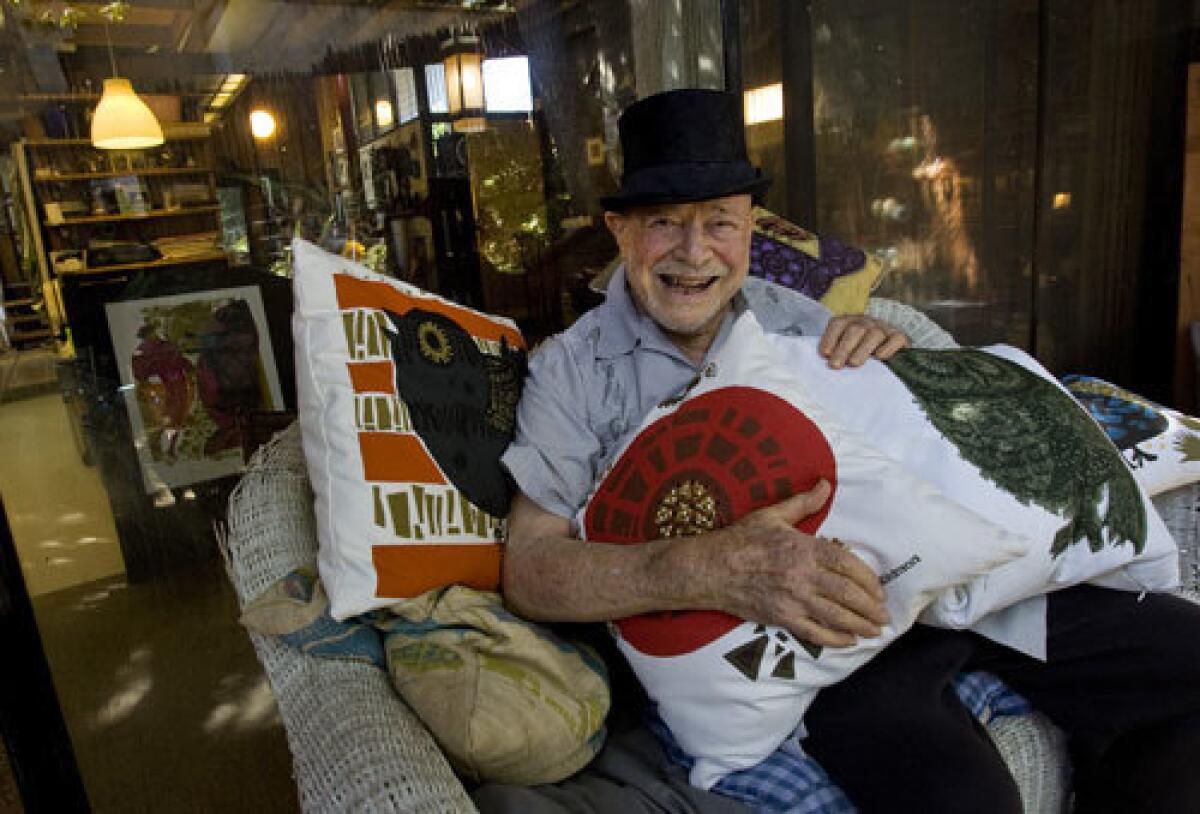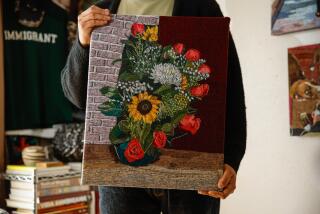Vintage whimsy

On a visit to the Long Beach area in the early 1960s, David and Dorothy Weidman had their first glimpse of a planned community. David saw tract homes; Dorothy saw opportunity. “All those houses are going to need pictures for the walls,” Dorothy recalls telling her husband, then a background painter for cartoons such as “Mr. Magoo” and “Crusader Rabbit.” She urged him to take up silk-screening.
So he did. From 1964 to 1979, David produced enough art for several subdivisions. Working in the back room of his Weidman Gallery, a vintage poster and framing shop on La Cienega Boulevard, he created about 300 designs and made thousands of serigraphs by hand. Few of Weidman’s richly textured prints — modestly priced from $10 to $50 — ever found homes, though. “It was a complete flop,” Dorothy says.
Now, at age 89, David Weidman is experiencing more than a renaissance. It’s his heyday, thanks to a devoted following of collectors, admirers and entrepreneurs bringing his work to a wider audience. Youth-oriented retailer Urban Outfitters is introducing the artist to a new generation through Weidman pillows and wall art. Gingko Press is in its third printing of “The Whimsical Works of David Weidman and Also Some Serious Ones,” a 2009 career retrospective of a man whose name may have little resonance but whose groovy style is instantly recognizable among many children of the 1960s and ‘70s.
“He’s the best almost-undiscovered designer in Los Angeles,” says Michael Giaimo, 56, a Disney animation art director who reveres Weidman as a master. “The sunny, optimistic tone of his work is quintessentially Southern Californian, and there’s an overtly decorative element to his work that creates a folksy quality, which is more embracing to the general viewer than fine art.”
Andrea Bernstein, owner of the Los Angeles-based Millwork Group, licensed Weidman images for use as textile prints in about 100 Urban Outfitters stores. She says the first set of 500 Weidman products sold out online in 48 hours.
“Even though they were done in the ‘60s,” Bernstein says, “David’s designs looked really modern and fresh to me.”
Indeed, the Weidman revival is not your typical retro trend fueled by nostalgia. For many of the buyers, Weidman’s prints — and artistic approach — are entirely new, animator Darrell Van Citters says.
“Despite being printed, the artwork looks hand done, which it was,” he says, adding that the highly stylized technique appeals to a contemporary audience. “It appears at first to be a simple statement, until you realize it’s really a very complex interplay of shapes, colors and rhythms.”
Steve Zeitzoff, 35, who wrote the new Weidman book with Roger Gastman, first discovered the artist’s work at a local flea market.
“My grandmother likes it just as much as my friends who write graffiti,” Zeitzoff says. “When David Weidman draws a dog or cat, there is just a really humorous expressive feeling. When I see David’s nature work and landscapes, I just want to live in those prints.”
That urge to live in a Weidman world is shared by advertising copywriter John Ballon, 40.
“The work reminds me of the fun things that were made for kids’ rooms in the 1960s like Lisa Larson’s ceramic animals and Evelyn Ackerman’s tapestries,” says Ballon, who has purchased pieces directly from Weidman at by-appointment visits to the artist’s home gallery. “I have 11 pieces, which is pretty ridiculous for someone who lives in a two-bedroom apartment.”
The Weidmans still live in a rambling Highland Park home, which they designed and built themselves in the 1950s on a hillside lot bought at a city auction for less than $1,000. David Weidman’s touch is everywhere: in the hand-lettered address out front, in the ceramic mailbox, in tiles surrounding the studio door and on bathroom cabinets printed with his graphics. It was his wife, however, who shaped the house’s modernist form.
“I grew up in a bungalow near Boyle Heights,” David Weidman says. “I didn’t know anything about architecture.”
The couple met in art school after World War II. He was a precocious painter who had mastered the then-popular illustration style of Norman Rockwell. She taught silk-screen printing.
“I didn’t take her class, but I dated her for a couple of years,” he says, “and then she gave me the ultimatum.”
They married in 1953. Weidman pored over magazine advertisements at the library, learning about building materials: cinder block, Douglas fir beams and panels, louvered windows, sliding doors, cork flooring and mahogany cabinetry. With the Weidman-designed built-ins, the house is filled with a lifetime of souvenirs but remains a compelling example of midcentury open-plan living.
Weidman’s work in cartoon animation and print illustration, meanwhile, put food on the table but didn’t satisfy his artistic ambitions. Inspired by Matisse, Picasso, Chagall and Ben Shahn, Weidman took up silk-screen printing and pushed the medium forward with innovative techniques.
“I was the best thief in the business,” he says, grinning. “I would steal right and left but intelligently, without leaving fingerprints, in such a way that it became mine.”
Indeed, Weidman’s prints spanned moods and styles. Some looked like woodcut prints or pen-and-ink cartoons. Others had the imprint of Scandinavian design or some other ethnic decoration. Humor and a genuine affection for the world informed most of his work.
In one of his best-loved prints, “Monkey Business,” Weidman sketched a little girl looking at a petite primate.
“It was an actual life story,” he says, citing one experience in downtown L.A. “I was at Olvera Street and that little girl was intrigued and scared and hiding behind her mom and peeking out. It was so touching.”
Weidman’s three children appeared in his prints, as did family pets such as the hound named Willy Bark, who got its name, the artist says, “because we never knew if he would or not.”
Commercial art historian Amid Amidi, author of “Cartoon Modern: Style and Design in Fifties Animation,” says Weidman’s biggest success was transferring the whimsical sensibility of his animation work and fine art training into powerful designs for silk-screening.
“Weidman represents a bygone era in commercial art when you had to have actual skill to be an illustrator,” he says, explaining Weidman’s appeal to a younger generation. “In his time, it wasn’t enough to simply know how to push a few buttons.”
The renewed interest in Weidman’s work has yet to reap a financial windfall, says his daughter, Lenna, who maintains a website, https://www.weidmansart.com, where her father’s prints are sold. An August show is planned for the Vintage Collective in Long Beach. A line of stationery may be forthcoming too. It’s a lot of work, Lenna Weidman says, “but finally there are people who understand that his work is not just authentic to the period but are graphic statements.”
On a recent afternoon at their home, her parents complete each other’s sentences with the banter of a screwball comedy team. They turn their attention to the Urban Outfitters pillows.
“It’s peculiar to me,” Dorothy says of her husband’s sudden popularity. “I’m just not used to it.”
Weidman says he never dwelled on rejection and instead focused on the future. Now he can smile with satisfaction about the present.
“I am pleased,” he says. “I can’t say I am not.” Hhis work has stood the test of time — “and that’s the true test of a work of art.”






